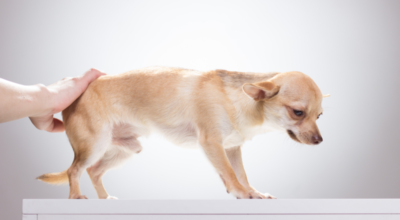Our beloved pets should be happy, healthy, and injury-free. And yeah! Pet accidents are terrifying. A prevalent injury in this tiny pooch is bone fracture in Chihuahua. Since chihuahuas commonly break their fragile bones. Chihuahua bone fractures may lead to pain, movement issues, and distress. This issue must be understood.
Let’s discuss chihuahua bone fracture kinds, causes, symptoms, and treatment for a quick recovery.
Factors Contributing to Bone Fractures in Chihuahuas

Various factors can contribute to bone fractures in chihuahuas, and it’s crucial to be aware of them to understand how you can prevent them.
1: Chihuahua Bone Fragility
Chihuahuas’ diminutive stature makes their bones fragile and prone to fractures. Even a slight fall or mishap can shatter their delicate bones. Keep Chihuahuas away from rough play and activities that might strain their bones.
2: Ignorance of Chihuahua Limitations
Lack of information regarding Chihuahuas’ physical limitations contributes to bone fractures. Due to their diminutive stature, Chihuahuas are sometimes underestimated as fragile. Owners may unwittingly expose their pets to fracture-causing behaviors like jumping from heights or playing with larger canines. To protect Chihuahuas, we must understand their needs and weaknesses.
3: Nutritional Deficits
Healthy bones in Chihuahuas depend on proper nourishment. Insufficient calcium, vitamin D, and phosphorus consumption weaken bones, leaving them more prone to fractures. Consult a vet to offer a well-balanced meal that fits Chihuahua nutritional needs.
4: Slippery Surfaces
Chihuahuas’ fragile bones and tiny stature make them more susceptible to slips. Smooth flooring, tiles, and polished hardwood can cause bone fractures. Provide rugs or mats in locations where they spend the majority of their time to improve footing and reduce slips and falls.
5: Overexertion and High-Impact Activities
Chihuahuas are active, but they need exercise. High-impact activities like leaping, running on hard surfaces, or excessive play might fracture their bones. To avoid injuries, moderate activity in a controlled setting is recommended.
Identifying Bone Fractures Chihuahua

How do you spot a Chihuahua bone fracture? See these frequent signs:
➙Limping
If your Chihuahua suddenly favors one leg or refuses to put weight on it, it may have a bone fracture. Watch for gait changes or mobility issues.
Localized edema around the damaged region is a common symptom of fractures. Watch for puffiness or swelling around your Chihuahua’s legs, paws, or joints.
➙Acute Pain or Discomfort
Touching or moving a fractured chihuahua may cause agony. They may whine, yell, or avoid the wounded leg.
➙Abnormal Movement
A leg deformity or irregular mobility may suggest a bone fracture. If the afflicted part seems misplaced or your Chihuahua can’t move it, seek medical assistance immediately.
➙Reluctance to Bear Weight
Chihuahuas with a bone fracture may hesitate to put weight on the affected limb. They may try to balance their weight on the remaining three legs or show signs of lameness. If you observe such behavior, it is a strong indicator of a potential fracture.
Taking Action: If you suspect your Chihuahua may have a bone fracture based on the signs mentioned above, it is crucial to take immediate action. Contact your veterinarian and describe the symptoms you have observed. They will guide you on the next steps to provide the necessary care for your furry friend.
Chihuahua Bone Fracture Prevention
Accidents might happen, but you can avoid bone fractures in chihuahuas.
✔️Supervising Playtime and Exercise
Chihuahuas are small and fragile dogs, making them more prone to fractures from high-impact activities or rough play. Supervising their playtime and exercise is essential to ensure they do not engage in activities that may lead to injuries. Additionally, it is crucial to provide adequate rest breaks during physical activity to prevent fatigue and overexertion.
✔️Create a Safe Environment:
Keep floors clear of clutter and remove any potential hazards your pup could trip over or collide with. Secure loose cables, rugs, and objects that may cause your Chihuahua to slip or fall. Maintaining a tidy living space will minimize the risk of accidental injuries.
✔️Provide Adequate Exercise:
Proper exercise is essential for keeping strong bones and muscles in Chihuahuas. Give your dog moderate exercise like walks, playtime, and games. Exercise strengthens bones, improves coordination, and boosts agility. However, Chihuahuas have fragile bones and may break easily, so be aware of their small and limits. Your Chihuahua’s exercise plan should be determined by your vet.
✔️Care and Support:
Chihuahuas are little and sensitive, requiring constant careful touch. Lift and carry your dog with support, focusing on their legs and back. Avoid quick or jerky motions that might fracture bones. To avoid accidents, teach your kids and dogs how to interact with your Chihuahua.
✔️Provide a Balanced Diet:
Nutrition plays a vital role in maintaining strong bones and preventing fractures. Ensure your Chihuahua’s diet includes appropriate amounts of calcium, phosphorus, and other essential nutrients. Consult your veterinarian for advice on choosing the right dog food or supplements promoting bone health. A balanced diet will help keep your pup’s bones strong and resilient.
✔️Regular Veterinary Check-ups:
Regular visits to the veterinarian are essential for monitoring your Chihuahua’s overall health and identifying any potential issues early on. During these check-ups, your vet can assess your dog’s bone density and provide appropriate recommendations to prevent fractures. They may also suggest specific supplements or treatments based on your Chihuahua’s individual needs.
Taking proactive measures will ensure your Chihuahua’s well-being and provide you peace of mind, knowing you’re doing everything possible to keep them safe and healthy.
First Aid for Bone Fractures in Chihuahua

Knowing how to provide first aid for a bone fracture in your Chihuahua is crucial for their well-being and comfort. While immediate veterinary care is necessary, there are actions you can take to stabilize the injury and ensure safe transport to the veterinarian. This section will explore the first aid measures for bone fractures in Chihuahuas, including stabilization techniques, safe transportation, and dos and don’ts in handling an injured dog.
Stabilization Techniques for Immediate Care
When faced with a bone fracture in your Chihuahua, it’s essential to provide immediate care to stabilize the injury. Here are some techniques to consider:
- Cover open fractures: If the fracture has caused an open wound, it’s important to cover it to prevent further contamination. Ideally, use a sterile gauze dressing. In the absence of sterile gauze, a clean cloth or feminine pad can be used to cover the opening.
- Immobilize the fracture: In order to prevent further damage and minimize pain, it’s crucial to immobilize the fractured area. Gently support the affected limb using a splint or a rolled towel to limit movement. Be careful not to apply excessive pressure or restrict blood circulation.
- Minimize movement: Avoid unnecessary movement of your Chihuahua, as this can worsen the fracture. Keep them calm and restrict their activity as much as possible until they receive proper veterinary care.
How to Safely Transport an Injured Chihuahua to the Vet
Transporting an injured Chihuahua safely to the veterinarian is essential to prevent further harm and ensure prompt treatment. Follow these guidelines:
- Use a carrier or a blanket: Place your injured Chihuahua in a secure carrier or wrap them gently in a blanket, ensuring their comfort and stability during transportation. Avoid putting pressure on the injured area.
- Minimize movement: Keep the journey smooth, avoiding sudden stops or sharp turns. Opt for a quiet and calm environment to minimize stress for your Chihuahua.
- Seek veterinary assistance immediately: Remember, time is of the essence when it comes to bone fractures. Contact your veterinarian as soon as possible to inform them about the situation and schedule an emergency appointment.
These steps may seem simple, but they can make a big difference in the well-being of your Chihuahua. In addition to following these guidelines, staying calm and reassuring your pet with gentle words and touch during the transportation process is crucial.
Dos and Don’ts in Handling a Chihuahua with a Suspected Fracture
When handling a Chihuahua with a suspected fracture, it’s essential to follow certain guidelines to ensure their safety and prevent further injury. Here are some dos and don’ts to keep in mind:
✅Dos:
- Do remain calm and speak softly to reassure your Chihuahua.
- Do approach your dog gently and carefully, avoiding sudden movements that could cause pain or distress.
- Do seek immediate veterinary attention for a professional diagnosis and treatment plan.
❎Don’ts:
- Don’t attempt to set or manipulate the fractured bone yourself, as this can worsen the injury.
- Don’t apply excessive pressure or force to the affected area.
- Don’t delay seeking veterinary care, as prompt treatment is crucial for proper healing.
Providing first aid for a bone fracture in your Chihuahua is the first step towards their recovery. By stabilizing the injury, safely transporting your pet to the vet, and following appropriate handling practices, you can ensure their well-being and give them the best chance for a successful treatment. Always consult a veterinarian for a professional evaluation and guidance when dealing with a bone fracture in your Chihuahua.
Veterinary Diagnosis and Treatment Options Bone Fracture in Chihuahua
If medical attention is sought promptly, most bone fractures in Chihuahuas can be treated successfully. However, the treatment plan will vary depending on the type and severity of the fracture.
➫Veterinary Diagnosis
When diagnosing a bone fracture in your Chihuahua, a visit to the veterinarian is crucial. The veterinarian will conduct a thorough physical examination, which may involve palpating the affected area, observing your dog’s movements, and assessing any signs of pain or discomfort. Diagnostic imaging techniques such as X-rays may also be used to confirm the presence of a fracture and determine its severity.
➫Types of Bone Fractures
Bone fractures in Chihuahuas can vary in type and location. Common types include:
- Complete fractures (where the bone breaks into two or more pieces).
- Incomplete fractures (where the bone cracks but doesn’t completely break).
- Compound fractures (where the broken bone pierces through the skin).
The location of the fracture, whether in the leg, back, or elsewhere, will also influence the treatment approach.
➫Treatment Options
The treatment approach for bone fractures in Chihuahuas depends on several factors, including the type of fracture, its location, and your dog’s overall health. Here are some common treatment options:
- Splinting or Casting: For less severe fractures, immobilizing the affected area with a splint or cast may be sufficient. It helps to stabilize the bone and promote natural healing over time.
- Surgical Intervention: In more complex fractures, surgery may be necessary. This could involve the use of pins, plates, or screws to realign the broken bone and secure it in place. The veterinarian will determine the most appropriate surgical procedure based on the specific fracture and location.
- Pain Management: Alongside any treatment option, your veterinarian will prioritize pain management for your Chihuahua. This may involve administering pain medication or anti-inflammatory drugs to alleviate discomfort during healing.
➫Rehabilitation and Recovery
After the initial treatment, your Chihuahua will require a period of rest and rehabilitation to aid in their recovery. Your veterinarian may recommend restricted activity, limited movement, and gentle exercises to strengthen the affected area. It’s crucial to follow their guidance closely to ensure proper healing and prevent further complications.
Potential Complications

While bone fractures in Chihuahuas can usually be successfully treated with proper care, it’s important to be aware of potential complications during recovery. Understanding these complications will help you take appropriate precautions and seek timely veterinary assistance.
1: Internal Injuries
In some cases, bone fractures can cause internal injuries in Chihuahuas. When a bone breaks, sharp edges or fragments can damage surrounding tissues, blood vessels, or organs. This can result in internal bleeding, bruising, or even puncture wounds. It’s important to keep an eye out for any signs of internal injuries, such as pale gums, rapid breathing, or abdominal pain, and seek immediate veterinary care if you suspect any complications.
2: Infection
Open fractures, where the broken bone pierces through the skin, carry a higher risk of infection. The exposed wound provides an entry point for bacteria, increasing the likelihood of infection. It’s crucial to keep the area clean and follow your veterinarian’s instructions on wound care to minimize the risk of infection. Symptoms of infection may include redness, swelling, discharge, or a foul odor around the affected area.
3: Delayed Healing
Some bone fractures may experience delayed healing or non-union, where the bones do not properly fuse together. Factors such as poor blood supply to the fractured site, inadequate immobilization, or underlying health conditions can contribute to this complication. Your veterinarian will monitor the healing progress and may recommend additional interventions, such as bone grafting or extended rest, to promote proper healing.
4: Mobility Issues
Bone fractures can significantly impact a Chihuahua’s mobility, especially if the fracture occurs in a weight-bearing bone or joint. Complications such as misalignment, stiffness, or muscle atrophy can hinder their ability to walk, run, or jump. Rehabilitation exercises, physical therapy, and consistent monitoring by your veterinarian can help improve mobility and regain strength.
While bone fractures can present potential complications for Chihuahuas, being armed with knowledge and proactive prevention measures can significantly improve their well-being.
Frequently Asked Questions
Is it possible for Chihuahuas to have hairline fractures that are hard to detect?
Yes, Chihuahuas can have hairline fractures that are difficult to detect. Hairline fractures, also known as stress fractures, can occur due to repetitive stress or overuse of a bone. These fractures are often small and may not show up on X-rays immediately. However, they can cause pain and discomfort for your Chihuahua. If you notice any signs of limping, difficulty walking, or tenderness in your dog’s limbs, it’s important to seek veterinary attention for a thorough examination.
What breeds of Chihuahuas are more prone to bone fractures?
All Chihuahuas, regardless of breed variation (such as long-haired or short-haired), can be prone to bone fractures. However, certain factors can increase their susceptibility. Chihuahuas with smaller bone structures, such as teacup or toy Chihuahuas, may be more at risk.
Additionally, Chihuahuas with weaker or less dense bones, such as those with osteoporosis or certain genetic conditions, may also be more prone to fractures. It’s important to provide proper care and precautions for all Chihuahuas to minimize the risk of bone fractures.
Is surgery always necessary for treating bone fractures in Chihuahuas?
Surgery is not always necessary for treating bone fractures in Chihuahuas. The treatment approach depends on various factors, including the type and severity of the fracture. In some cases, less severe fractures can be managed with splinting or casting, which immobilize the affected area and allow the bone to heal naturally.
However, more complex fractures involving joint or bone misalignment may require surgical intervention to realign and stabilize the bone. Your veterinarian will evaluate your Chihuahua’s situation and recommend the most appropriate treatment plan.
How long does it typically take for a Chihuahua’s bone fracture to heal?
The healing time for a Chihuahua’s bone fracture can vary depending on several factors, including the location and severity of the fracture, the age and overall health of the dog, and the chosen treatment method. Generally, a bone fracture can take a few weeks to several months to fully heal in Chihuahuas. Following your veterinarian’s instructions regarding rest, medication, and rehabilitation exercises during the healing process is important to promote proper recovery.
Can Chihuahuas experience chronic pain after a bone fracture has healed?
Chihuahuas can experience chronic pain after a bone fracture has healed, although this is not always true. Some Chihuahuas may develop complications or residual pain due to joint stiffness, muscle imbalances, or nerve damage.
Suppose you notice your Chihuahua showing signs of ongoing discomfort, such as reluctance to bear weight on the affected limb, difficulty moving, or changes in behavior. In that case, it’s important to consult with your veterinarian. They can assess your dog’s condition and recommend appropriate pain management strategies or further treatment if necessary.
Can older Chihuahuas be more susceptible to bone fractures?
Yes, older Chihuahuas can be more susceptible to bone fractures. As dogs age, their bones can become more brittle and less resilient. This can increase the risk of fractures, even with minor accidents or falls. Older Chihuahuas may also have conditions such as osteoporosis or arthritis, further weakening their bones and making them more prone to fractures. Providing a safe environment, regular veterinary check-ups, and appropriate exercise and nutrition can help minimize the risk of bone fractures in older Chihuahuas and promote their overall bone health.
Final Words
When it comes to our beloved chihuahuas, the last thing we want to see is them in pain. Unfortunately, bone fractures in chihuahuas are more common than we might expect. As pet owners, it’s important to be aware of the signs and symptoms to provide our furry friends with the best possible care. Whether it’s a result of rough play, accidents, or simply weakened bones, bone fractures can be a traumatic experience for both chihuahua and owner alike.
But with proper treatment and care, our little companions can fully recover and continue waging their tails joyfully. Never hesitate to seek help from a trusted veterinarian if you suspect your chihuahua has suffered a bone fracture. After all, our furry friends are a part of the family and deserve the same attention and care as any other loved one.
Here at ILoveChihuahua, we share our personal experiences as owners of this feisty breed. We talk about recommended methods, dog supplies picks, and advice on common Chihuahua problems. Our goal is to promote responsible dog ownership, so there would be fewer Chihuahuas in shelters.


